|
|
|
Sort Order |
|
|
|
Items / Page
|
|
|
|
|
|
|
| Srl | Item |
| 1 |
ID:
126659
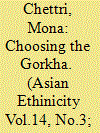

|
|
|
|
|
| Publication |
2013.
|
| Summary/Abstract |
The Darjeeling hills in northern West Bengal, India are being demanded as a homeland for the Gorkha community living in India. While the origin of Darjeeling is steeped in the imperial legacy of the British Raj, the Gorkha, a colonial construct is ironically used as a means to challenge the contemporary political regression and neo-colonisation of Darjeeling. Although the Gorkha identity is deemed as representative of the Nepali community residing in India, it acquires special meaning and importance in the Darjeeling hills, where majority of the people suffer low wages, unemployment, underdevelopment and poverty. In spite of a large working force in the tea estates, economic underdevelopment and political disempowerment is voiced through the assertion of ethnic rather than a class-based identity. Through an examination of the interaction between class and ethnicity, the Gorkha identity will highlight the malleability of ethnicity to extend itself to any situation and the emergence of an ethnic identity from class relations and grievances.
|
|
|
|
|
|
|
|
|
|
|
|
|
|
|
|
| 2 |
ID:
126660
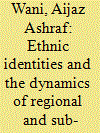

|
|
|
|
|
| Publication |
2013.
|
| Summary/Abstract |
The concept of regional and sub-regional identity as well as regional autonomy has captured the stage of Social Science. The regional autonomy aspirations and the sense of regional and sub-regional identity have offered a new dimension to the assertiveness of ethnic group. Regional identity demands in South and Southeast Asian societies have followed a uniform pattern. These regional autonomy demands evolved over a large span of time may be located in specific geographical and environmental spaces. At one level, these demands remained humane and inclusive, incorporating and reflecting broader human and universal values. At the other level, they acquired the traits of particularism which in the later stages of building multi-cultural and multi-ethnic nation states posed many problems. The plurality of politics is the hallmark of Jammu and Kashmir (J&K) State, and this polarity is essentially the result of cultural diversities that criss-cross the geographical and cultural landscape of Kashmir. The J&K State is not only a conglomerate of three distinct regions - Jammu, Kashmir, and Ladakh - but there are also regions within regions marked off from one another by geography, culture, and history. The politics of regional and sub-regionalism based on region, religion, caste, ethnicity, and so on continues to be stubbornly informed by their respective histories and cultures - thus the resistance against hegemony and the demand for sub-regional autonomies and Hill Development Councils. This article attempts at, looking into the dynamics of these assertions, its impact on the politics of the state, and to delineate the role of different socio-political and historical forces in shaping regional and sub-regional assertions in J&K without, however, suppressing the relative significance of different identity markers.
|
|
|
|
|
|
|
|
|
|
|
|
|
|
|
|
| 3 |
ID:
126661
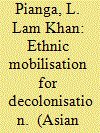

|
|
|
|
|
| Publication |
2013.
|
| Summary/Abstract |
This article attempts to communicate the methodological tension between subjectivity and objectivity by recording the aspiration of communities who are problematised both by colonialism and the modern nation-state. It highlights how colonial policy and practice contribute to the postcolonial imbroglio in Northeast India. It delineates how British colonial cartography always gave priority to 'administrative convenience' in the demarcation of boundaries, resulting in the division of ethnic community. It argues that Northeast India and the Indo-Burma borderland are not yet decolonised, as the government of India, without any rearrangement or alteration, adopts the colonial administrative boundaries, which divided ethnic communities. Neither the State Reorganisation Act (1956) nor the North-Eastern Areas (Reorganisation) Act (1971) fulfilled the aspiration of the segmented communities in the northeast, as they did in the mainland. The article also argues that the responses of the government of India towards the problems in Northeast India react to the manifested symptoms of the deep-rooted political problem rather than getting to the crux of the problem to find a solution.
|
|
|
|
|
|
|
|
|
|
|
|
|
|
|
|
| 4 |
ID:
126666
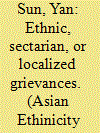

|
|
|
|
|
| Publication |
2013.
|
| Summary/Abstract |
Since its ?rst occurrence in 2009. the total number of Tibetan self-immolations had reached 97 by the end of 20l2. with an additional 10 or so in the fu'st three months of 20l3. However. our understanding of this shocking act remains limited. Why did those Tibetans resort to such an extreme form of protest? What were their motives? What were their grievances'? What objectives did they intend to achieve? Wang Lixiong. a dissident Chinese scholar-writer and respected authority on Tibetan affairs, attempts to answer these questions by analyzing the last words of more than two dozen self-immolators who had left final notes.' His data are derived from infomiation collected by his Tibetan wife. Woeser. who is also a dissident writer. Below I will introduce Wang's major ?ndings and evaluate them in the light of two competing perspectives
|
|
|
|
|
|
|
|
|
|
|
|
|
|
|
|
| 5 |
ID:
126662
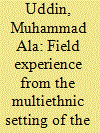

|
|
|
|
|
| Publication |
2013.
|
| Summary/Abstract |
Conducting research in the home country brings diverse experiences to a researcher as the researcher is considered as both insider and outsider by the informants. I conducted fieldwork in the Chittagong Hill Tracts - a multiethnic setting situated in the southeastern part of Bangladesh - where I was considered both insider and outsider. In the light of such experiences, in this article I discuss the researcher's position and the level of engagement - how a researcher situates himself or herself in the field and gathers information from different people. This article also discusses briefly the methodological procedures of the study.
|
|
|
|
|
|
|
|
|
|
|
|
|
|
|
|
| 6 |
ID:
126658
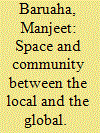

|
|
|
|
|
| Publication |
2013.
|
| Summary/Abstract |
The objective of this article is to situate the relation between the local and the global in the context of a specific region formation, namely the Brahmaputra Valley of Assam in India as a frontier. The article takes up two examples on the relation between space and community construct and how the relation forms part of the deeper relation between the local and the global in the Valley. The Brahmaputra Valley comprises the major area of the Indian state of Assam. Assam and its neighbouring areas are also referred to as 'North East India'. The term came into use during the colonial period. It was used to refer to the British-Indian frontier which bordered on Bhutan, Tibet, China and Myanmar. In the first example of the article, the local-global relation is seen in terms of how the colonial-capitalism paradigm altered the pre-colonial socio-spatial relation, formulating and implementing new spatial and social classifications. The focus in the example is on the rearrangement of socio-spatial relations in the Valley as part of transforming a pre-colonial crossroads into a colonial frontier. In the second example, the relation between space and community construct is situated in popular responses to the above changes, and especially how international ideology like communism is appropriated to address the local specificity of frontier. The works of the cultural icon and peasant leader of the Valley, Bishnu Rabha, are discussed in detail. Through the interrelation between the two examples, the article tries to show how between the nineteenth and the mid-twentieth century the local specificity of the Valley as a frontier was possible precisely due to changes of state formation or ideology which drew on a global context. In other words, the relation between space and community construct in the Valley demonstrates how the coexistence of the local and the global was a necessary condition in its making as a frontier. Community constructs like 'tribe', 'Assamese' and 'Ahom' during the period formed part of this interrelation between the local and the global that
|
|
|
|
|
|
|
|
|
|
|
|
|
|
|
|
|
|
|
|
|